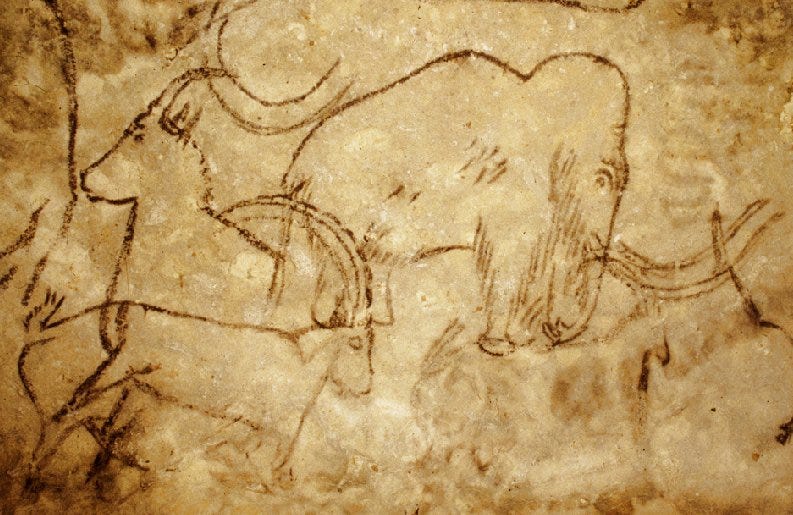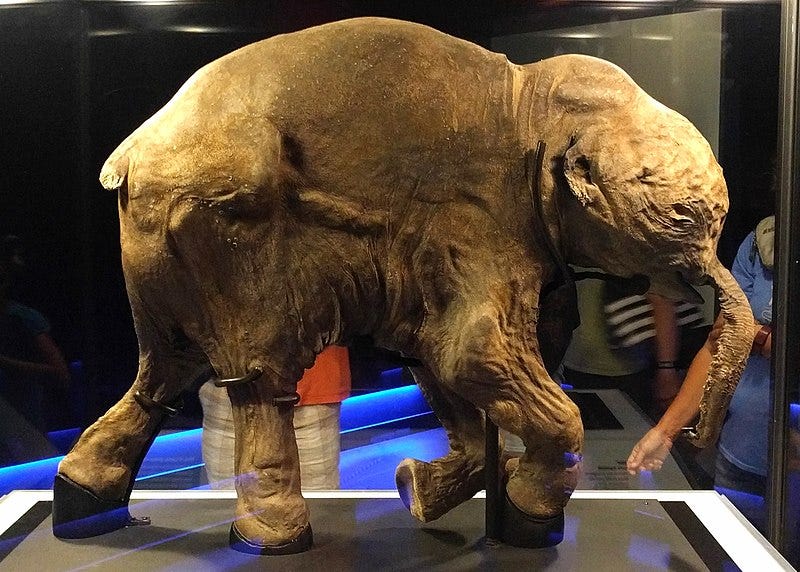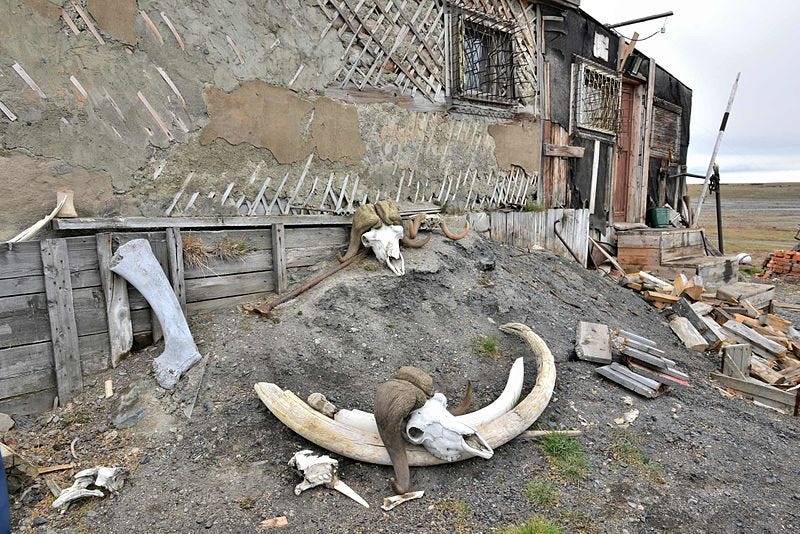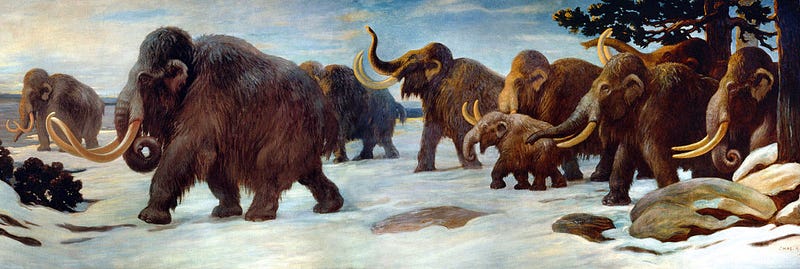# The Woolly Mammoth's Heartbreaking Demise: A Genetic Journey
Written on
Chapter 1: The Woolly Mammoth's Final Days
The woolly mammoth, a colossal creature of the Ice Age, met its end on Wrangel Island approximately 4,000 years ago, coinciding with the era of the great pyramids of Giza. This island, situated in the Arctic Ocean near the Russia-U.S. border, measures roughly the size of Crete. Sadly, the last mammoth was in dire straits: it had lost its ability to smell, shrunk in size, and its once-thick fur was ineffective against the cold. Afflicted by conditions like diabetes and infertility, this majestic beast ultimately succumbed to its hardships, marking the extinction of a once-mighty species.
You might wonder how this creature, believed to have perished at the end of the Last Ice Age around 10,500 years ago, survived for so long. While mammoths vanished from most parts of Eurasia and North America, a small population remained on Wrangel Island, the final refuge for these magnificent giants.
Why Was the Extinction of the Mammoth So Heartbreaking?
What circumstances led these creatures to inhabit such a remote location? My curiosity about their final days compelled me to delve deeper into their history. Thanks to advancements in genetic research, we now possess insights into the woolly mammoth's evolutionary journey, illuminating how this species became emblematic of the Ice Age.
Chapter 2: Evolutionary Insights

The woolly mammoth is one of the most extensively studied extinct species. Unlike dinosaurs, we have a clear picture of what they looked like, thanks to cave drawings created by our ancestors who coexisted with these beasts. Numerous mammoth skeletons and mummies, preserved in permafrost across regions like Siberia, Alaska, and Canada, validate these artistic representations. Some specimens have been found with intact eyes, hair, and tusks, and countless bodies still remain frozen in the permafrost.
Paleontologist Steve Brusatte likens the discovery of these remains to “mammoths falling out like walnuts in a puddle of melting Rocky Road ice cream.”
Woolly mammoths were comparable in size to modern African elephants. Males reached about 3 meters (10 feet) in height and could weigh up to 8 tons, while females were slightly smaller, averaging between 2.5 to 2.9 meters (8.5 to 9.5 feet) and around 6 tons. Interestingly, the closest living relative of the woolly mammoth is the Asian elephant, not the African elephant.
The woolly mammoth (Mammuthus primigenius) thrived on Earth for approximately 800,000 years, evolving from the steppe mammoth (Mammuthus trogontherii) until its extinction 4,000 years ago. To understand their last days, we must first explore how they adapted to survive the Ice Age.
Adaptations for Survival
The woolly mammoth's most distinctive feature was its thick fur. This creature sported two layers of hair: an outer layer of long hairs, up to three feet in length, forming a protective cloak, and a shorter, fluffier undercoat beneath. The fur secreted oils to repel snow and water, providing insulation. Contrary to popular belief, mammoth fur came in various colors, including blond, orange, brown, and black.
How do we know this? The story of this Ice Age giant is embedded in its DNA. Extensive research has been conducted on mammoth DNA due to the well-preserved mummies found in permafrost.

Genetic studies have revealed intriguing details about the mammoth. Scientists have identified genes linked to the mammoth's small ears and tail compared to elephants, as well as those responsible for its thick fur, large sebaceous glands, and increased body fat. Mutations enabled them to endure prolonged dark winters, and elevated hemoglobin levels allowed them to thrive in frigid conditions.
Understanding these evolutionary traits is crucial as we examine how the last remaining mammoths became mere shadows of their formidable ancestors.
The Isolation of Wrangel Island
Why were these creatures confined to a small island? What happened to the mammoths that once roamed across Eurasia and North America? The scientific community debates whether hunting or climate change led to their extinction, though it is likely that both factors contributed.
Numerous Upper Paleolithic artifacts, dating from 50,000 to 12,000 years ago, such as the renowned Venus figurines, were crafted from mammoth ivory. In Mezhyrich, Ukraine, archaeologists uncovered homes built using the bones of these majestic animals. A 2019 study indicated that during the Late Pleistocene (129,000 to 11,700 years ago), mammoth tusks were often used to create hunting tools like spears and arrows.
Could these findings imply that hunting led to their extinction? Many paleontologists dismiss this theory.

While there is ample evidence of humans hunting mammoths, the structures found at Mezhyrich do not support the idea of widespread slaughter. Instead, they were built using remains from various eras collected from the steppes.
As the planet warmed at the conclusion of the Last Ice Age (14,000 to 10,500 years ago), grasslands were replaced by forests, significantly altering the mammoth's habitat. Consequently, these creatures vanished from mainland Europe, Asia, and North America. The last sightings occurred in the Taymyr Peninsula, Siberia, around 11,100 years ago, and in the New Siberian Islands (then connected to the mainland) about 10,700 years ago.
However, the story of the mammoth did not end there. Isolated from the rest of the world, these creatures survived for an additional 6,000 years.
Chapter 3: The Last Stand on Wrangel Island
In this short video, "When Did the Last Wooly Mammoth Die: History in a Minute (Episode 98)," we explore the timeline and circumstances surrounding the extinction of the woolly mammoth, including its final days on Wrangel Island.
The video, "Extinction of the Mighty: The Tragic End of the Woolly Mammoth," delves into the factors that led to the mammoth's decline and the genetic anomalies that emerged from their isolation.
In 1993, researcher Sergey Vartanyan from the Russian Academy of Sciences made a groundbreaking discovery. Radiocarbon dating revealed that woolly mammoths, once thought extinct after the Ice Age, survived on Wrangel Island until 4,000 years ago. The island became isolated from mainland Siberia about 12,000 years ago due to rising sea levels, trapping the mammoths and cutting them off from the rest of the world. While St. Paul Island in the Bering Sea also hosted mammoths until around 5,600 years ago, Wrangel Island marked their final refuge.
Despite a population of 500 to 1,000, these last mammoths were unable to endure the isolation. In 2015, a team of international researchers, including renowned geneticist David Reich, analyzed the DNA of ten Wrangel Island mammoths from 4,300 years ago and compared it to that of a 45,000-year-old mammoth from Oimyakon, Siberia. They discovered numerous genetic mutations in the Wrangel Island mammoths that were absent in their mainland ancestors.
Due to their small population, these woolly mammoths suffered from severe inbreeding, leading to a decline in genetic diversity and resulting in what is termed a mutational meltdown.
Understanding Mutational Meltdown
A mutational meltdown occurs when harmful mutations accumulate due to a restricted gene pool, exacerbating undesirable traits. While natural selection typically eliminates detrimental mutations, inbreeding allows a significant portion to persist in subsequent generations.

What undesirable traits emerged in the last mammoths? Researcher Rebekah Rogers identified a significant mutation in the FOXQ1 gene, which led to the development of translucent, satin-like hair in the mammoths. This mutation affected the hair's ability to repel snow and ice, rendering the evolutionary adaptations of thousands of years ineffective.
Additionally, the Wrangel Island mammoths exhibited a loss of olfactory receptors, impairing their sense of smell. They also lacked several proteins related to urine, which likely impacted their social hierarchy and mating choices.
In 2020, a team led by evolutionary biologist Vincent Lynch further investigated these mutations. They compared the DNA of the Wrangel Island mammoths to earlier mammoths and modern Asian elephants. By regenerating the cells of the Wrangel Island mammoths in the lab, they validated predictions about the impact of the mutations.
Lynch's team identified several key issues faced by the Wrangel Island mammoths, including: - Developmental abnormalities caused by mutations in the HYLS1 gene. - Alterations in the NKD1 gene that adversely affected male fertility. - A prevalence of diabetes resulting from changes in the NEUROG3 gene. - Mutations in the OR5A1 gene that impaired their ability to detect floral scents.
The consequences of isolation and a limited genetic pool took a severe toll on the last woolly mammoths. They lived with compromised health, unable to smell, struggling to shake off snow, and suffering from diabetes and infertility. The inability to detect the flowers they relied on for sustenance further complicated their already difficult existence.
The Final Chapter: Human Interaction or Genetic Decline?
Could these creatures have survived despite their deteriorating health? Was it possible that the arrival of humans on Wrangel Island dealt the final blow?
While it is tempting to assume that humans were responsible for the extinction of the last woolly mammoths, archaeological evidence reveals that the earliest human presence at Chertov Ovrag, a site on Wrangel Island, occurred nearly four centuries after the mammoths had vanished. There is no indication that humans hunted the remaining mammoths on the island.
The most plausible explanation for the extinction of the woolly mammoth is inbreeding, which led to health issues and ultimately the demise of this iconic Ice Age creature.
Key Takeaways: The Woolly Mammoth's Legacy

Woolly mammoths outlasted many Ice Age megafauna, such as saber-toothed cats and woolly rhinos. Thanks to the rich steppe vegetation on Wrangel Island, they managed to survive for 6,000 years after their presumed extinction. Genetic studies have provided valuable insights into the last days of the mammoth, revealing significant details about their evolution and decline.
To summarize, the woolly mammoth descended from the steppe mammoth around 800,000 years ago and became extinct approximately 4,000 years ago. They evolved a thick fur coat that repelled snow and kept them warm, well-suited for life in the tundra. Climate change and human hunting likely contributed to their disappearance from mainland Eurasia and North America.
The last woolly mammoths thrived on Wrangel Island, but their isolation and limited numbers led to inbreeding and reduced genetic diversity, resulting in a mutational meltdown. This caused them to become physically weaker, suffer from diabetes, and lose the ability to smell. Ultimately, the last woolly mammoth breathed its last breath 4,000 years ago.
If you find the world of prehistoric creatures fascinating, be sure to check out the story of a paleontologist who prepared a 50,000-year-old bison meal for an unforgettable dinner party.
What Does a 50,000-Year-Old Bison Stew Taste Like? Explore the culinary experience of a famous prehistoric meal prepared by paleontologist Dale Guthrie.
If you're intrigued by this tale and wish to learn more about the past, subscribe to my posts to stay updated. Your thoughts and feedback are welcome in the comments section!
References - Eleftheria Palkopoulou et al. (2015) "Complete Genomes Reveal Signatures of Demographic and Genetic Declines in the Woolly Mammoth." Current Biology. - Rebekah Rogers et al. (2017) "Excess of genomic defects in a woolly mammoth on Wrangel Island." PLoS Genetics. - Sebastian Pfeifer et al. (2019) "Mammoth ivory was the most suitable osseous raw material for the production of Late Pleistocene big game projectile points." Scientific Reports. - Vincent Lynch et al. (2020) "Functional Architecture of Deleterious Genetic Variants in the Genome of a Wrangel Island Mammoth." Genome Biology and Evolution. - Anthony J. Stuart (2021) Vanished Giants: The Lost World of the Ice Age, University of Chicago Press. - Steve Brusatte (2022) The Rise and Reign of Mammals, Picador.